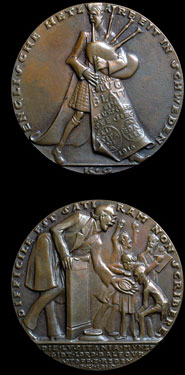|
The above title from a satirical poem written by Juvenal was used by Karl Goetz on his medal "English Smear Campaign in Sweden," K-156(a), which is part of the group of World War I medals commonly called "the satirical medals." They range from opus 131 to opus 306 and cover the years from 1913 to 1923. In these medals Goetz sometimes depicted war events in an intentionally damaging fashion. A satirist is a man who employs humor as one means to an end, but not as the end itself. In satire laughter is a weapon used to ridicule and to evoke moral indignation. Goetz used humor to criticize, good-naturedly or otherwise, people and institutions he felt needed criticism. Although these satirical medals were quite popular in the years during and after World War I, and seem now to be regaining popularity, they are sometimes highly controversial. Some are very bitter, if not too bitter, yet they always illustrated the true feelings of the general public in Germany.
Some things which Goetz attacks through satire he later glorifies in other medals. Others, he admires first, but ridicules afterwards.
|

|